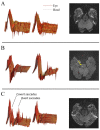Video-Oculography-Assisted Head Impulse Test and Caloric Testing for Detecting Stroke in Acute Vertigo Patients via Modified HINTS Plus
- PMID: 34640489
- PMCID: PMC8509535
- DOI: 10.3390/jcm10194471
Video-Oculography-Assisted Head Impulse Test and Caloric Testing for Detecting Stroke in Acute Vertigo Patients via Modified HINTS Plus
Abstract
Background: We assessed whether detection of stroke underlying acute vertigo using HINTS plus (head-impulse test, nystagmus type, test of skew, hearing loss) can be improved by video-oculography for automated head-impulse test (V-HIT) analysis.
Methods: We evaluated patients with acute vestibular syndrome (AVS) presenting to the emergency room using HINTS plus and V-HIT-assisted HINTS plus in a randomized sequence followed by cranial MRI and caloric testing. Image-confirmed posterior circulation stroke or vertebrobasilar TIA were the reference standards to calculate diagnostic accuracy. We repeated statistical analysis for a third protocol that was composed post hoc by replacing the head-impulse test with caloric testing in the HINTS plus protocol.
Results: We included 30 AVS patients (ages 55.4 ± 17.2 years, 14 females). Of these, 11 (36.7%) had posterior circulation stroke (n = 4) or TIA (n = 7). Acute V-HIT-assisted HINTS plus was feasible and displayed tendentially higher accuracy than conventional HINTS plus (sensitivity: 81.8%, 95% CI 48.2-97.7%; specificity 31.6%, 95% CI 12.6-56.6% vs. sensitivity 72.7%, 95% CI 39.0-94.0%; specificity 36.8%, 95% CI 16.3-61.6%). The new caloric-supported algorithm showed high accuracy (sensitivity 100%, 95% CI 66.4-100%; specificity 66.7%, 95% CI 41-86.7%).
Conclusions: Our study provides pilot data on V-HIT-assisted HINTS plus for acute AVS assessment and indicates the diagnostic value of integrated acute caloric testing.
Keywords: HINTS; V-HIT; acute vestibular syndrome; dizziness; neurology; stroke; vertigo; video-oculography.
Conflict of interest statement
T.S. is an editorial board member of J. Clin. Med. C.G., E.S., A.S., H.H.K., L.P., J.B., H.R., V.P. and K.B. declare no conflict of interest.
Figures




References
-
- Saber Tehrani A.S., Kattah J.C., Mantokoudis G., Pula J.H., Nair D., Blitz A., Ying S., Hanley D.F., Zee D.S., Newman-Toker D.E. Small strokes causing severe vertigo: Frequency of false-negative MRIs and nonlacunar mechanisms. Neurology. 2014;83:169–173. doi: 10.1212/WNL.0000000000000573. - DOI - PMC - PubMed
LinkOut - more resources
Full Text Sources

